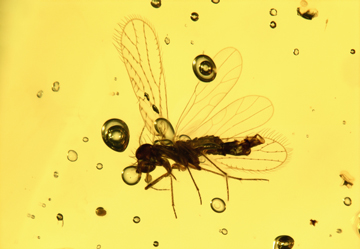Abstract
The crown wasps, family Stephanidae, are generally believed to occupy a distinguished position as putative relicts of the earliest-diverging lineage of apocritan Hymenoptera (e.g., Sharkey et al., 2012; Mao et al., 2015). More recent analyses have cast some confusion over this hypothesis, with the family instead appearing closer to the Evanioidea or even Trigonalyoidea (Peters et al., 2017; Tang et al., 2019). From most analyses it is clear that the family extends well into the Cretaceous, with crown-group Stephanidae estimated to have appeared by at least the Early Cretaceous and a purported ghost-stem lineage extending into the Early Jurassic or even latest Triassic (Tang et al., 2019). At least parts of such a hypothesis are consistent with the number of mid-Cretaceous fossils representing a variety of crown wasps, including species of both the plesiomorphic subfamily Schlettereriinae as well as putative Stephaninae (Engel & Grimaldi, 2004; Engel et al., 2013; Engel & Huang, 2017; Li et al., 2017). Unfortunately, while such fossil occurrences are of considerable interest, the total available record of fossil crown wasps is poor, with most species documented from the Palaeogene (Engel, 2005; Engel & Ortega-Blanco, 2008), and hitherto only four species from the Late Cretaceous. Given the potentially long gap between the first divergence of the lineage and the appearance of the crown group (Tang et al., 2019), it is precisely for such a group that early diverging stem groups would be of considerable value in resolving relationships and documenting the appearance of apomorphies within the clade. Extensive study of Early Cretaceous and Jurassic deposits for stem-group Stephanidae is necessary in order to provide direct evidence into the early evolution of this critical family of the Euhymenoptera.
References
Achterberg, C., van (2002) A revision of the Old World species of Megischus Brullé, Stephanus Jurine and Pseudomegischus gen. nov., with a key to the genera of the family Stephanidae (Hymenoptera: Stephanoidea). Zoologische Verhandelingen, 339, 3–206.
Aguiar, A.P. (1998) Revisão do gênero Hemistephanus Enderlein, 1906 (Hymenoptera: Stephanidae), com considerações metodológicas. Revista Brasileira de Entomologia, 41 (24), 343–429.
Engel, M.S. (2005) The crown wasp Electrostephanus (Hymenoptera: Stephanidae): discovery of the female and a new species. Polskie Pismo Entomologiczne, 74 (3), 317–332.
Engel, M.S. & Grimaldi, D.A. (2004) The first Mesozoic stephanid wasp (Hymenoptera: Stephanidae). Journal of Paleontology, 78 (6), 1192–1197.
https://doi.org/10.1017/S0022336000044000
Engel, M.S. & Huang, D.Y. (2017) A new crown wasp in Cretaceous amber from Myanmar (Hymenoptera: Stephanidae). Cretaceous Research, 69, 56–61.
https://doi.org/10.1016/j.cretres.2016.08.014
Engel, M.S. & Ortega-Blanco, J. (2008) The fossil crown wasp Electrostephanus petiolatus Brues in Baltic amber (Hymenoptera, Stephanidae): designation of a neotype, revised classification, and a key to amber Stephanidae. ZooKeys, 4, 55–64.
https://doi.org/10.3897/zookeys.4.49
Engel, M.S., Grimaldi, D.A. & Ortega-Blanco, J. (2013) A stephanid wasp in mid-Cretaceous Burmese amber (Hymenoptera: Stephanidae), with comments on the antiquity of the hymenopteran radiation. Journal of the Kansas Entomological Society, 86 (3), 244–252.
https://doi.org/10.2317/JKES130206.1
Grimaldi, D.A., & Ross, A.J. (2017) Extraordinary Lagerstätten in amber, with particular reference to the Cretaceous of Burma. In: Fraser, N.C., & Sues, H.-D. (Eds.), Terrestrial conservation Lagerstätten: Windows into the evolution of life on land. Dunedin Press, Edinburgh, pp. 287–342.
Huber, J.T. & Sharkey, M.J. (1993) Structure. In: Goulet, H. & Huber, J.T. (Eds.), Hymenoptera of the world: an identification guide to families. Agriculture Canada, Ottawa, pp. 13–59.
Leach, W.E. (1815) Entomology. In: Brewster, D. (Ed.), The Edinburgh Encyclopædia [Volume 9, Part 1]. Balfour, Edinburgh, pp. 57–172.
Li, L.G., Rasnitsyn, A.P., Labandeira, C.C., Shih, C.K. & Ren, D. (2017) Phylogeny of Stephanidae (Hymenoptera: Apocrita) with a new genus from Upper Cretaceous Myanmar amber. Systematic Entomology, 42 (1), 194–203.
https://doi.org/10.1111/syen.12202
Mao, M., Gibson, T. & Dowton, M. (2015) Higher-level phylogeny of the Hymenoptera inferred from mitochondrial genomes. Molecular Phylogenetics and Evolution, 84, 34–43.
https://doi.org/10.1016/j.ympev.2014.12.009
Peters, R.S., Krogmann, L., Mayer, C., Donath, A., Gunkel, S., Meusemann, K., Kozlov, A., Podsiadlowski, L., Petersen, M., Lanfear, R., Diez, P.A., Heraty, J., Kjer, K.M., Klopfstein, S., Meier, R., Polidori, C., Schmitt, T., Liu, S., Zhou, X., Wappler, T., Rust, J., Misof, B. & Niehuis, O. (2017) Evolutionary history of the Hymenoptera. Current Biology, 27 (7), 1013–1018.
https://doi.org/10.1016/j.cub.2017.01.027
Sharkey, M.J. & Wharton, R.A. (1997) Morphology and terminology. In: Wharton, R.A., Marsh, P.M. & Sharkey, M.J. (Eds.), Manual of the New World genera of the family Braconidae (Hymenoptera). International Society of Hymenopterists, Washington, D.C., pp. 19–37.
Sharkey, M.J., Carpenter, J.M., Vilhelmsen, L., Heraty, J., Liljeblad, J., Dowling, A.P.G., Schulmeister, S., Murray, D., Deans, A.R., Krogmann, L. & Wheeler, W.C. (2012) Phylogenetic relationships among superfamilies of Hymenoptera. Cladistics, 28 (1), 80–112.
https://doi.org/10.1111/j.1096-0031.2011.00366.x
Shi, G., Grimaldi, D.A., Harlow, G.E., Wang, J., Wang, J., Yang, M., Lei, W., Li, Q., & Li, X. (2012) Age constraint on Burmese amber based on U-Pb dating of zircons. Cretaceous Research, 37, 155–163.
https://doi.org/10.1016/j.cretres.2012.03.014
Tang, P., Zhu, J.C., Zheng, B.Y., Wei, S.J., Sharkey, M., Chen, X.X. & Vogler, A.P. (2019) Mitochondrial phylogenomics of the Hymenoptera. Molecular Phylogenetics and Evolution, 131, 8–18.
https://doi.org/10.1016/j.ympev.2018.10.040
Yu, T.T., Kelly, R., Mu, L., Ross, A., Kennedy, J., Broly, P., Xia F.Y., Zhang, H.C., Wang, B. & Dilcher, D. (2019) An ammonite trapped in Burmese amber. Proceedings of the National Academy of Sciences, U.S.A., 116 (23), 11345–11350.

